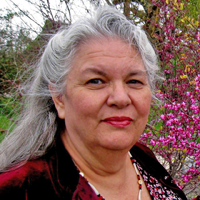Kathy Wallace

Kathy Wallace is a professor of college courses on California Indians and Native American basket-weaving at San Francisco State University and is a founding board member of the California Indian Basket-weavers Association (CIBA). She actively participates in restoration efforts at
the Cache Creek Nature Preserve.
Can you tell me your name and your relationship to this place?
I am Kathy Wallace. My relationship to this place, started out with a UCD student approaching me on a project that she was working on and she wanted to get my input… She had read about basket weavers and the problems basket weavers have finding material to use, she thought that maybe some how she could incorporate basket weaving material into a garden project she was planning… She brought me out here and I meet with Jan Lowry, who was the director at the time and we talked. I had some questions that I usually ask…one of them was asking if there was any opportunity, if we did plant materials in this area for baskets, that we could burn them? Burn them once a year or once every other year, to make the materials better. I explained how the burning process improves the materials, takes care of competition, and helps keep the bugs in balance. He [then Cache Creek Conservancy Executive Director Jan Lowrey] said that he would really consider burning; there was a possibility they could do that. I had never received that answer before. Usually they say, “There is NO way”. But he said we could burn and so then I got really interested.
Did you make it a point to incorporate local Native American council with The Tending and Gathering Garden?
I really felt it was important that if she (the student’s name was Shannon Brawley) was going to do something for Native Americans that it be with Native Americans with their consultation and advice from the very start of the project... She agreed to that and so did Jan. I said it would be really good to have an advisory committee of some sort… I came up with a long list I kept adding too, adding too, but I wanted to make sure we included local native groups from around the area. Even if they lived quite a ways away, I knew they would have some connection to this area and so we did… We ended up with a core group of people. So we kept them notified and anytime we’d have a meeting we made sure they got minutes. Every time we had some major event we invited everybody. So that was a really important part of this part of the garden and because of it we got a lot of support from native people and from the people they knew and people they were involved in, within other projects…The whole project and the preserve have gotten a really good reputation among Native American people and then as an offshoot of that, other places wanted to do the same thing.
Did you know that you were receiving outside attention?
We did realize it was something new and different. We were doing things that people had talked about but nobody had really done. Not locally anyways. One of the important things was realizing that we were not making a place where people could come and gather and harvest we were making a place where basket weaving teachers and elders could bring student to show them what plants looked like when they were growing, what they looked like at different stages, to maybe gather some, to show them how to gather, and how to use some… We didn’t need huge extensive garden space, acres and acres. We just needed a showcase of basketry plants.
How do you think the Cache Creek Nature Preserve stands as an example to other communities?
When you bring somebody out to a place like the Cache Creek Nature Preserve, it is a little reminder: this is the way it could be, this is the way it used to be, this is the way it could be again. It gives you hope.
Why is it important for people to come to the CCNP?
When you start thinking about the land, as your landscape, your home, you’re going to have a different feeling about it. That’s what I feel is really important: connecting people to a landscape.
Why is it important to bring children out to the Preserve?
Children don’t have that opportunity to do this very often anymore, [be in] a safe place where they can see who comes in and who goes out. It’s safe for them to go on the trails and to look at things, for them to discover things on their own then come back and ask questions about it.
What did your students take away from learning in the Tending and Gathering Garden?
My students have a whole different view of plants, animals and the things around them. If everybody connected [with the land] in an artistic way, if they gather rocks or material to make something with, it would be a reminder of that place.
How have you developed a relationship to this land?
I will probably come back the rest of my life, just to check on things, to see how things are going. And so now I have this connection with this place.
To download the audio, right click on the audio link above and scroll
to "Save link as . . ." and choose the directory where you want to
store the mp3. In Windows, you may have to use Control + S to select the link.